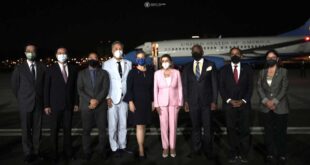Giancarlo Elia Valori
Why do the United States and Iran keep on fighting each other? The dispute between the United States and Iran began 68 years ago. Since then, new developments added from time to time.
In 1953, the U.S. intelligence agency CIA, together with the British MI-6, staged a coup in that country. Both intelligence services overthrew the elected Prime Minister, Mohammad Mossadeq, for their own benefit, and restored Shah Reza Pahlavi of Iran to the Peacock Throne. Later the U.S. oil companies (the Seven Sisters) and the British ones massively took advantage of the Iranian crude oil trade for a long time. Mohammed Mossadeq, instead, wanted to nationalise the oil companies and that is why he was overthrown. For the first time in its history, the United States overthrew an elected government at a time when there were no wars going on.
Nevertheless, there was an Italian interference that upset the U.S. and British plans. Enrico Mattei suggested to Iran that those who produced oil should not pocket only paltry extraction rights and royalties from companies, without being able to intervene and have a say in the matter, but should be able to participate in the organisation, responsibility and production, as well as supervision.
In simple terms, Iran and Italy would set up a company with a 50% shareholding each, which would pay 50% of royalties to the Iranian State and the remaining 50% would be divided equally between ENI and the National Iranian Oil Company (NIOC).
Actually, since NIOC was a state-owned company, the Iranian State benefited from 75% of the agreement (25% more than the Anglo-American fifty-fifty rule) and – no less important – from direct technological participation in the oil and gas exploration and extraction activities.
The agreement between ENI and NIOC was signed on March 14, 1957. On September 8, 1957, the two companies established the Societé Irano-Italienne des Pétroles (SIRIP). Eni-Agip was responsible for oil exploration activities, with the agreement that expenses would be reimbursed if oil reserves and fields were discovered on Iranian soil.
The relationship on an equal footing was welcomed and supported by the newly independent Near East and Middle East countries, freed from Franco-British domination (it should be recalled that we were in the aftermath of the second Arab-Israeli war).
For those international legal entities, the lack of a serious and violent Italian colonialist policy and the defeat in World War II were guarantees of maximum solidity.
Enrico Mattei’s activity annoyed the Seven Sisters, who saw the danger of a destabilisation of the oil supply from the Middle East and, above all, the risk of weakening their own cartel position. Enrico Mattei’s and ENI’s activity began to become a threat to the world order that had emerged victorious from the Second World War and was almost entirely in the United States’ hands.
The U.S. government itself put much pressure on Italy to avoid the ENI-Iran deal. The agreement was just one of the challenges Mattei threw down to the Seven Sisters. Other important moves were made by Enrico Mattei who sought direct agreements with Egypt, Algeria, monarchist Libya and the Soviet Union. Mattei died in a plane crash on October 27, 1962.
We can say that the Iranian revolution of 1978-79 was the response to the U.S. coup staged in Iran twenty-six years earlier.
On February 1, 1979, Ayatollah Khomeini returned to Iran and took power. Before the Islamic revolution of 1979 in Iran, Khomeini lived in exile in Turkey, Iraq and France. During the Shah’s rule, Khomeini targeted the Iranian government for forced Westernisation and increasing dependence on the United States. To make matters worse, Shah Reza Pahlavi – the U.S. “maverick” and free agent in the Middle East – urged the White House to set up a secret police, the notorious Savak, to protect his corrupt bureaucracy.
After Ayatollah Khomeini rose to power, there was the crisis of the U.S. embassy in Iran. Again in 1979, a group of Iranian students in Tehran held 52 U.S. citizens hostage for over a year (from November 4, 1979 to January 20, 1981). There was a break in diplomatic relations upon U.S. initiative and the failure of the attempt to free the hostages, made by the Carter Administration (Operation Eagle Claw, April 24, 1980, with a toll of eight people dead and four wounded, as well as the loss of six helicopters and a cargo plane).
In the meantime, Saddam Hussein crossed Iran’s borders on September 22, 1980 and attempted to invade Iran. This resulted in a war between the two countries that caused over a million deaths.
The United States, as well as Great Britain and the Soviet Union, were on Saddam Hussein’s side: coincidentally, the three countries that had occupied Iran in 1941. The following States supported Iran: the Democratic People’s Republic of Korea (North Korea), Libya, Syria, as well as Afghan and Pakistani volunteers, and socialist Albania (the latter from a propaganda and diplomatic viewpoint).
In 1982, Iran began to react, regaining lost ground and starting to advance towards the Iraqi city of Basra. Because of the fear that Iran could defeat Iraq and thus influence other countries of the Association of South-East Asian Nations (Philippines, Indonesia, Malaysia, Singapore and Thailand) where the Muslim presence was strong, the United States began to support Saddam’s regime ever more and arranged for Iraq to import weapons, including non-U.S. weapons. At the same time, the United States confiscated weapons that the Iranian government had already paid for during the Shah’s time. This led to further resentment in Iran.
The United States, which made so many mistakes in its history, had left the Shah behind, but continued to act against the new Iranian government. Declassified documents show that even before the Revolution, the U.S. diplomacy had contacts with the Khomeinist group, including the Ayatollah himself. However, with a view not to ‘abandoning friends’, in November 1979 the Shah was allowed to be hosted in the United States for health treatment.
This harshly irritated the already suspicious Iranian revolutionaries, who feared that the U.S. intelligence services were plotting to bring him back as it had already done in 1953 during the time of Mohammad Mossadeq. The reaction at that point was the aforementioned embassy crisis.
A student leader stated: ‘We have occupied this embassy, a den of espionage, as a form of protest […] We have announced we are protesting against the U.S. asylum to the Shah, whose hands are stained with the blood of countless Iranian men and women’.
In 1983, there were two attacks in Beirut, Lebanon on the U.S. embassy and the Marine Corps barracks, causing 362 deaths, while another attack was launched on French barracks, in which 58 soldiers were killed.
A Shi’ite organisation claimed responsibility, and intelligence sources said it was loyal to Iran. Five years later (July 3, 1988), when the United States stationed its Navy warships in the Persian Gulf, the U.S. cruiser Vincennes fired a missile to shoot down the Iranian passenger plane Iran Air 655 flying over the Strait of Hormuz (Iran’s territorial waters), killing all 290 people on board. The United States later claimed that the ship had mistaken the airliner for an incoming fighter, but it never apologised. Iran accused the United States of intentionally shooting down the civilian aircraft.
In 1984, the United States described Iran as a country that fuelled terrorism, first accusing it of supporting Lebanese Hezbollah and other armed groups, and later Hamas in Palestine.
Iran always denied any involvement and accused Western countries (including the United States) of assisting anti-Iranian terrorist organisations, including Saddam Hussein.
U.S. President Reagan (1981-1989) called Iran a ‘rogue country’. President George W. Bush (2001-2009) went so far as to include Iran in the ‘axis of evil’, claiming that Iran not only supported terrorism, but also sought to obtain weapons of mass destruction.
As disagreements over Iran’s nuclear activities escalated and numerous sanctions were imposed on the country, Iranian President Mahmoud Ahmadinejad dismissed those who accused Iran, including President Bush, as being ‘mentally retarded’.
It was only on July 14, 2015, when the Iranian nuclear deal (Joint Comprehensive Plan of Action – JCPA) was reached between Iran and the five U.N. Security Council countries plus Germany, that the tension between the two countries began to briefly ease.
Currently, however, the relationship between the two countries has worsened more than ever. The latest public opinion poll has shown the extent to which U.S. relations with Iran have continued to deteriorate.
A poll conducted by the BBC World News channel in 2013 (two years before the JCPA) showed that 87% of Americans have a mostly negative concept of Iran.
A poll conducted in 2018 by a Canadian analyst firm showed that 81% of Iranians have very or somewhat negative views of the United States.
It should also be noted that early last November, President Donald Trump asked whether there was any possibility of attacking Iran’s main nuclear site (Natanz). Although he ultimately decided not to proceed, it is clear that improving bilateral relations is a step that cannot be easily taken from one Presidency to another.
 Geostrategic Media Political Commentary, Analysis, Security, Defense
Geostrategic Media Political Commentary, Analysis, Security, Defense





